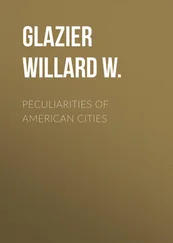Willard Glazier - Ocean to Ocean on Horseback
Здесь есть возможность читать онлайн «Willard Glazier - Ocean to Ocean on Horseback» — ознакомительный отрывок электронной книги совершенно бесплатно, а после прочтения отрывка купить полную версию. В некоторых случаях можно слушать аудио, скачать через торрент в формате fb2 и присутствует краткое содержание. Жанр: foreign_antique, foreign_prose, Путешествия и география, на английском языке. Описание произведения, (предисловие) а так же отзывы посетителей доступны на портале библиотеки ЛибКат.
- Название:Ocean to Ocean on Horseback
- Автор:
- Жанр:
- Год:неизвестен
- ISBN:нет данных
- Рейтинг книги:4 / 5. Голосов: 1
-
Избранное:Добавить в избранное
- Отзывы:
-
Ваша оценка:
- 80
- 1
- 2
- 3
- 4
- 5
Ocean to Ocean on Horseback: краткое содержание, описание и аннотация
Предлагаем к чтению аннотацию, описание, краткое содержание или предисловие (зависит от того, что написал сам автор книги «Ocean to Ocean on Horseback»). Если вы не нашли необходимую информацию о книге — напишите в комментариях, мы постараемся отыскать её.
Ocean to Ocean on Horseback — читать онлайн ознакомительный отрывок
Ниже представлен текст книги, разбитый по страницам. Система сохранения места последней прочитанной страницы, позволяет с удобством читать онлайн бесплатно книгу «Ocean to Ocean on Horseback», без необходимости каждый раз заново искать на чём Вы остановились. Поставьте закладку, и сможете в любой момент перейти на страницу, на которой закончили чтение.
Интервал:
Закладка:
It abounds in relics, among which are the tattered shreds of flags brought back by Massachusetts soldiers from Southern battle-fields – a sight which must stir every loyal heart, to whatsoever State it owes allegiance; the guns carried by the Concord minute-men in the Revolutionary conflict; and duplicates of the gift to the State by Charles Sumner, of the memorial tablets of the Washington family in England. Doric Hall contains busts of Sumner, Adams, Lincoln, and other great men, and several fine statues – one of Washington, by Chantrey, and one by Thomas Ball; a speaking likeness in marble of John A. Andrew, the indomitable old War Governor of Massachusetts.
On the handsome terraces in front of the building stand two superb bronzes, one is the Horace Mann statue, by Emma Stebbins, which was erected in 1865, and paid for by contributions from teachers and school children all over Massachusetts; the other Hiram Powers' statue of Daniel Webster, which cost $10,000. It was erected in 1859, and was the second statue of Webster which the famous sculptor wrought, the first, the product of so much toil and pains and the embodiment of so much genius, having been lost at sea.
Last, but very far from least in importance, may be mentioned the historic codfish, which hangs from the ceiling of Assembly Hall, dangling before the eyes of the legislators in perpetual reminder of the source of Massachusetts' present greatness, for the codfish might by a stretch of Hibernian rhetoric be described as the patron saint of the Bay State.
I must confess to having been one of the 50,000 curious ones who, it is computed, annually ascend into the gilded cupola and "view the landscape o'er." The spectacle unrolled panorama-like before the sight is indeed a feast to the eyes.
The Old State House of 1748, built on the site of Boston's earliest town hall, is now used as a historical museum under the auspices of the Bostonian Society. Careful restoration has perpetuated many of the old associations which hallow the ancient fane, sacred to loyalty and to liberty. The old council-chambers have been given much of their original appearance, and the great carving of the Lion and the Unicorn, which savored of offence to patriotic nostrils and so was taken down from its gables in Revolutionary times, has been replaced. To visit this building is a liberal education in local history.
The Boston Post Office, of whose migrations I have spoken earlier, is now settled for good and all in a magnificent structure of Cape Ann granite, built in Renaissance style, whose corner-stone was laid in 1871 and which was just ready for the addition of the roof when the Great Fire of 1872 descended upon it and beat upon it so fiercely that even to-day the traces of the intense heat are visible on parts of the edifice. Damage to the amount of $175,000 was done. The Sub-Treasury, the United States courts, the pension and internal revenue offices are domiciled here, and it is considered the handsomest public building in all New England, having cost $6,000,000. The interior furnishings are sumptuous in the extreme, the doors and windows in the Sub-Treasury apartments being of solid mahogany, beautifully polished. The "marble cash-room" is a splendid hall, decorated in Greek style, with wall-slabbing of dark and light shades of Sienna marble and graceful pilasters of Sicilian marble.
The City Hall, on School street, is the seat of the municipal housekeeping. Here the departments of streets, water, lighting, police, and public printing have their offices, and Common Council sits in august assemblage. It is a commanding structure of granite, fireproof, and in the Renaissance style. Its cost was $500,000. Two fine bronze statues, one by Greenough, of Franklin, one by Ball, of Josiah Quincy, ornament the grassy square in front of the building.
No picture of Boston would be complete without that old landmark, Tremont Temple. It occupies the former site of the Tremont Theatre and contains one of the largest halls in the city. The building itself, however, sinks into insignificance before the crowd of associations that stir the blood at its very name. For years it has been the rallying point of Boston's most notable gatherings – political, intellectual, and religious. If, instead of colorless words, we could photograph upon this page the pictures those old walls have looked upon, we might revel in a gallery of famous portraits such as the world has rarely seen. Edward Everett, Wendell Phillips, William Lloyd Garrison, Joseph Cook, Phillips Brooks, and other master-spirits of the age, would be there. And there, too, would be a sprinkling of that other sex, no longer handicapped by the epithet "gentler."
But, could we press the phonograph as well as the camera into our service, and hear again the thunders of stormy oratory, the clash of political warfare, and the pleading tenderness of religious eloquence that has often resounded under that old roof, then indeed we might well forget the world of to-day in the fascination of this drama of the past.
Architecturally, Boston combines in the happiest way all that is beautiful and dignified in the classic models and all that is fresh and original in modern canons of building. A magnificent group of buildings, in the vicinity of Boylston and Huntingdon streets and Copley Square, fairly takes the breath away with its beauty. Trinity Church and the Museum of Fine Arts, the "New Old South Church" and the new Boston Public Library, form such a quartet of splendid edifices as even the travelled eye seldom sees. The Public Library is an embodied Triumph – the symbol of that great heritage of culture which the city pours out on her denizens as lavishly and as freely as water, and which, like "the gentle dew from heaven, blesseth him that gives and him that takes," returning to enrich the community with its diffused presence, like the showers which return to the bosom of the river, the moisture the sun only borrowed for a space. Bostonians have always been proud of their Public Library, from its foundation in 1852. By 1885, the Boylston street building, with accommodations for 250,000 volumes, was too contracted a space to hold the largest public library in the world, and with characteristic promptness the city rose to the occasion and embodied its thought that "nothing can be too good for the people" in the beautiful new library in Copley Square, which cost the royal sum of $2,600,000.
The long chapter of description which this splendid enterprise merits must be reluctantly crowded into a few lines. Nothing, however, save personal observation, can give an adequate perception of its outward loveliness; its exterior of soft cream-gray granite, with a succession of noble arched windows ranged along its fine façades; its arches, pillars and floorings of rare marbles, and its mosaics, panels and carvings. The grand staircase of splendid Sienna marble, opposite the main entrance, is one of the finest in the world; and scholar or philosopher could ask no more attractive spot for thoughtful promenade than the beautiful open court, with its marble basin and MacMonnies fountain in the centre, the soft green of its surrounding turf affording grateful rest to book-wearied eyes, and the pensive beauty of the cloister-like colonnade forming an ideal retreat.
The foremost artists of the world are represented in the interior decoration. The famous St. Gaudens seal, designed by Kenyon Cox and executed by Augustus St. Gaudens, ornaments the central arch of the main vestibule; the bronze doors are by Daniel G. French; the splendid marble lions in the staircase hall – erected as memorials to their martyred comrades by two regiments of Massachusetts volunteers – are by Louis St. Gaudens; and Puvis de Chavannes, James McNeil Whistler, Edwin A. Abbey and John S. Sargent are among the celebrated artists who have contributed to the mural decorations, friezes and ceiling frescoes.
Читать дальшеИнтервал:
Закладка:
Похожие книги на «Ocean to Ocean on Horseback»
Представляем Вашему вниманию похожие книги на «Ocean to Ocean on Horseback» списком для выбора. Мы отобрали схожую по названию и смыслу литературу в надежде предоставить читателям больше вариантов отыскать новые, интересные, ещё непрочитанные произведения.
Обсуждение, отзывы о книге «Ocean to Ocean on Horseback» и просто собственные мнения читателей. Оставьте ваши комментарии, напишите, что Вы думаете о произведении, его смысле или главных героях. Укажите что конкретно понравилось, а что нет, и почему Вы так считаете.





![Джон Сэндфорд - Ocean Prey [calibre]](/books/384313/dzhon-sendford-ocean-prey-calibre-thumb.webp)






